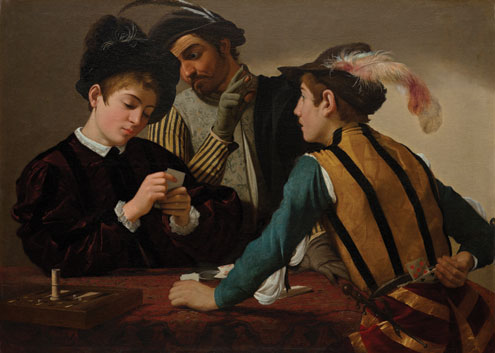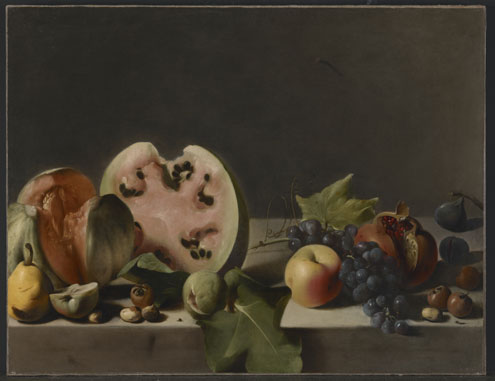The new acquisition is on view beginning today, as the Kimbells Caravaggio painting The Cardsharps (c. 159697) also returns on view after a loan to a celebrated exhibition at Romes Palazzo Barberini.

Caravaggio (Michelangelo Merisi), The Cardsharps, c. 159697, oil on canvas. Kimbell Art Museum
Fort Worth, Texas — The Kimbell Art Museum announced today the acquisition of Still Life with Melon, Watermelon, and Other Fruits, painted c. 161020 by the Italian artist known as Pensionante del Saraceni, the name historians have given to an as-yet-unidentified artist associated with a small group of paintings created in Rome around 161020. This quiet yet powerful work is among the finest and earliest of the independent still lifes painted in Italy in the wake of Caravaggio (Michelangelo Merisi), whose bold realism transformed the genre.
Simultaneously, Caravaggios Cardsharps (c. 159697) has returned to the Kimbell after being included in the historic exhibition Caravaggio 2025 at the Palazzo Barberini in Rome, which received more than 450,000 visitors. Both paintings are now on view at the Kimbell in the Louis I. Kahn Building.
The Pensionante del Saraceni is a fascinating and mysterious painter who worked among the Caravaggesque artists in Rome in the decade following Caravaggios death in 1610, said Eric M. Lee, director of the Kimbell Art Museum. Still Life with Melon, Watermelon, and Other Fruits is one of the artists most important paintings, and it will make a significant contribution to the Kimbells small but outstanding collections of still lifes and works influenced by Caravaggios distinctive style.

Pensionante del Saraceni, Still Life with Melon, Watermelon, and Other Fruits, c. 161020, oil on canvas. Kimbell Art Museum.
Still Life with Melon, Watermelon, and Other Fruits is an approximately two- by two-foot (55.5 x 71.5 cm) composition that presents two groups of near-life-sized fruits, fully ripe and ready to be eaten, balancing their varied contours and volumes. Soft, enveloping light reveals realistic yet poetic elements, including each fruits individual texture and color: a succulent orange cantaloupe, moist pink watermelon flesh, a leathery pomegranate with seeds like garnets, a cluster of dark blue grapes, a waxy red and yellow apple, and the dappled skin of a green pear. Like most still-life paintings, it stimulates the senses: a feast for the eyes, the fruit is fragrant, gustatory, and tactileyet momentarily silent, awaiting consumption.
The artists sophistication is evident in the tight framing of the composition, which barely crops the arrangement of fruits at either side. Set against a dark background, the objects are placed toward the front edge of a softly illuminated stone ledge, whose back edge is tipped slightly forward for display. The composition is brought close to the viewer, as curled leaves and grape tendrils, along with smaller fruits and scattered seeds strewn across the picture, enhance the feeling of proximity and tangibility. What at first seems to be distant darkness beyond the stone tabletop suddenly comes into focus as a nearby wall when the viewer notices an inconspicuous nail casting a soft shadow like a sundial.
Given the extremely high quality of the painting, it is surprising that we cannot put a name to its maker. The unidentified artist of Still Life with Melon, Watermelon, and Other Fruits has been nicknamed by historians the Pensionante del Saraceni, referring to someone who lodged with Carlo Saraceni (15791620), a Venetian painter working in Rome, and shows affinities with Saracenis paintings. (Saraceni is known to have taken in boarders.) The so-called Pensionante was likely Italian, though he may have been French, Netherlandish, or Spanish. His paintings show deep sympathy and understanding of Caravaggios innovative style. The Pensionante distinguishes himself as a master by his realism, soft lighting, and an overall restrained, calm, and poetic mood.
Unlike Caravaggios famous painting of blemished and insect-infested fruits and withered leaves, the Pensionantes still life does not immediately suggest vanitasthe passing of time that leads to mortality. Neither is it an idealized still life depicting perfect specimens. Rather, Still Life with a Melon, Watermelon, and Other Fruits exalts the natural world and the very real qualities of the fruitsall varieties that would have come to maturity in late summer or autumn, to be enjoyed in all their abundance.
Still Life with a Melon, Watermelon, and other Fruits joins other still lifes at the Kimbell including Jacques de Gheyns Vase of Flowers with a Curtain (1615); Louise Moillons Still Life with Strawberries, Basket of Cherries, and Branch of Gooseberries (1631); Jean Simeìon Chardins The Cut Melon (1760); Luis Meléndezs Still Life with Oranges, Jars, and Boxes of Sweets (c. 176065); and Anne Vallayer-Costers Still Life with Mackerel (1787). The new acquisition will now share a museum home with The Cardsharps (c. 159697) by Caravaggio, who influenced this and countless other works, enabling still life to enjoy a level of esteem and appreciation by the same patrons who acquired his portraits and religious paintings.
Other works at the Kimbell where Caravaggios influence is evident include Guercinos Christ and the Woman of Samaria (c. 161920) and Artemisia Gentileschis Penitent Mary Magdalene (162526). The Cardsharps, a visitor favorite and highlight of the Kimbells permanent collection, is now back on view in the Kahn Building after a five-month loan for the successful, extended exhibition Caravaggio 2025 at the Gallerie Nazionali di Arte Antica – Palazzo Barberini in Rome.
Provenance
(Anonymous sale, Hôtel des Ventes Pasteur, Antibes, 5 November 1988, no. 134, as Spanish school, 17th century); acquired by Jean Gismondi [19402014], Paris; his heirs, Paris; (Artcurial, Paris, Maîtres anciens & du XIXe siècles, 22 March 2023, lot 51, withdrawn); private collection, Paris; (with Nicholas Hall, New York, 2024); purchased by Kimbell Art Foundation, Fort Worth, 2025.
Support
Promotional support for the Kimbell Art Museum and its exhibitions is provided by American Airlines, NBC 5, and Fort Worth Report. Additional support is provided by Arts Fort Worth and the Texas Commission on the Arts.
Visitor information
Admission to the museums permanent collection is always free. Admission to special exhibitions is half-price all day on Tuesdays and after 5 p.m. on Fridays.
The Kimbell Art Museum is open Tuesdays through Thursdays and Saturdays, 10 a.m.5 p.m.; Fridays, noon8 p.m.; Sundays, noon5 p.m.; closed Mondays, New Years Day, Juneteenth, July 4, Thanksgiving, and Christmas. For general information, call 817-332-8451.
About the Kimbell Art Museum
The Kimbell Art Museum, owned and operated by the Kimbell Art Foundation, is internationally renowned for both its collections and its architecture. The Kimbells collections range in period from antiquity to the twentieth century and include European paintings and sculptures by artists such as Michelangelo, Caravaggio, Artemisia Gentileschi, Bernini, Velázquez, Gainsborough, Monet, Cézanne, Picasso, and Matisse, as well as important examples of Egyptian and classical antiquities. Also included are significant works of Asian art from China, Japan, the Himalayas, and South and Southeast Asia; notable African sculptures primarily from West and Central Africa; and a wide range of ancient American art representing cultures across Mexico and Central and South America.
The museums 1972 building, designed by the American architect Louis I. Kahn, is widely regarded as one of the outstanding architectural achievements of the modern era. A second building, designed by Italian architect Renzo Piano, opened in 2013 and now provides space for special exhibitions, dedicated classrooms, and a 289-seat auditorium with excellent acoustics for music. For more information, visit kimbellart.org.
